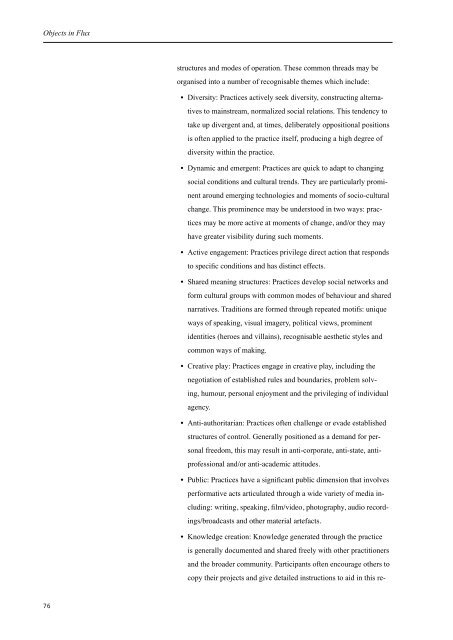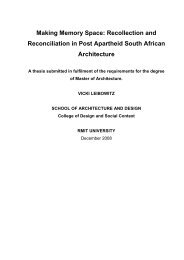Objects in Flux - RMIT Research Repository - RMIT University
Objects in Flux - RMIT Research Repository - RMIT University
Objects in Flux - RMIT Research Repository - RMIT University
Create successful ePaper yourself
Turn your PDF publications into a flip-book with our unique Google optimized e-Paper software.
<strong>Objects</strong> <strong>in</strong> <strong>Flux</strong><br />
76<br />
structures and modes of operation. These common threads may be<br />
organised <strong>in</strong>to a number of recognisable themes which <strong>in</strong>clude:<br />
• Diversity: Practices actively seek diversity, construct<strong>in</strong>g alternatives<br />
to ma<strong>in</strong>stream, normalized social relations. This tendency to<br />
take up divergent and, at times, deliberately oppositional positions<br />
is often applied to the practice itself, produc<strong>in</strong>g a high degree of<br />
diversity with<strong>in</strong> the practice.<br />
• Dynamic and emergent: Practices are quick to adapt to chang<strong>in</strong>g<br />
social conditions and cultural trends. They are particularly prom<strong>in</strong>ent<br />
around emerg<strong>in</strong>g technologies and moments of socio-cultural<br />
change. This prom<strong>in</strong>ence may be understood <strong>in</strong> two ways: practices<br />
may be more active at moments of change, and/or they may<br />
have greater visibility dur<strong>in</strong>g such moments.<br />
• Active engagement: Practices privilege direct action that responds<br />
to specific conditions and has dist<strong>in</strong>ct effects.<br />
• Shared mean<strong>in</strong>g structures: Practices develop social networks and<br />
form cultural groups with common modes of behaviour and shared<br />
narratives. Traditions are formed through repeated motifs: unique<br />
ways of speak<strong>in</strong>g, visual imagery, political views, prom<strong>in</strong>ent<br />
identities (heroes and villa<strong>in</strong>s), recognisable aesthetic styles and<br />
common ways of mak<strong>in</strong>g.<br />
• Creative play: Practices engage <strong>in</strong> creative play, <strong>in</strong>clud<strong>in</strong>g the<br />
negotiation of established rules and boundaries, problem solv<strong>in</strong>g,<br />
humour, personal enjoyment and the privileg<strong>in</strong>g of <strong>in</strong>dividual<br />
agency.<br />
• Anti-authoritarian: Practices often challenge or evade established<br />
structures of control. Generally positioned as a demand for personal<br />
freedom, this may result <strong>in</strong> anti-corporate, anti-state, antiprofessional<br />
and/or anti-academic attitudes.<br />
• Public: Practices have a significant public dimension that <strong>in</strong>volves<br />
performative acts articulated through a wide variety of media <strong>in</strong>clud<strong>in</strong>g:<br />
writ<strong>in</strong>g, speak<strong>in</strong>g, film/video, photography, audio record<strong>in</strong>gs/broadcasts<br />
and other material artefacts.<br />
• Knowledge creation: Knowledge generated through the practice<br />
is generally documented and shared freely with other practitioners<br />
and the broader community. Participants often encourage others to<br />
copy their projects and give detailed <strong>in</strong>structions to aid <strong>in</strong> this re-
















